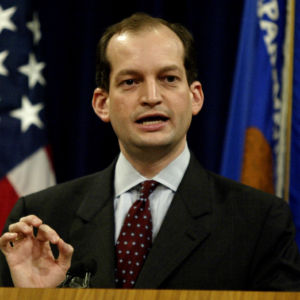Labor Secretary Alexander Acosta discussed why education and job training needs to be reformed during a conference Monday on fixing the skills gap.
The U.S. Chamber of Commerce Foundation for America Working Forward hosted the day-long event to explore potential solutions to the skills gap problem. The conference brought together employers, training providers, and policymakers who discussed the problem while offering thoughts on how to address it.
The Bureau of Labor Statistics (BLS) recently reported that job openings currently stand at 6.1 million. The monthly report saw a slight decrease from the previous month. At the same time, there are millions of working-age adults without work. Acosta highlighted how reforming the education system and expanding apprenticeship programs can help to bridge that gap.
“Our mission is quite clear, and it is to close the skills gap,” Acosta told the conference. “Now before we can solve a problem we need to define it. We have 6.1 million open jobs in this nation. This is almost the highest its ever been since the Bureau of Labor Statistics started tracking this figure. It was 6.2 last month. Other than that it is the highest figure ever of open jobs.”
Economists have proposed various solutions to potentially address the skills gap problem. Some have even doubted whether it is actually a problem. Some believe the skills gap is occurring because people are not being provided needed skills through school and training. Others assert the issue is the result of certain industries not paying adequate wages to attract skilled talent.
Acosta notes the education system needs to be reformed so that students have more career paths to explore. High schools typically prepare students for college, but Acosta warns that while a liberal arts education can be beneficial to many students, it might not always be the best for everyone.
“Before we can address the skills gap we need to acknowledge an underlying problem in how we educate our students,” Acosta said. “Those students are not presented a full and accurate range of career options during their secondary education. The student who loves building things in shop class might prefer to become a carpenter, and that could be a great career. The art student who has a passion for welding might decide that’s the career path for her.”
Acosta adds that schools need to provide students more career options while helping them to develop those skills. He warns that schools are currently defining success on whether they can prepare students for a narrowly focused set of career paths, and that the approach does a disservice to students who have an interest that could develop into a successful career elsewhere.
President Donald Trump has been particularly focused on apprenticeships as a potential solution. He signed an executive order June 15 aimed at increasing the number of apprenticeship programs by reducing regulations so it’s easier for companies, unions, and industry groups to create them.
“Apprenticeships are one way of incorporating demand-driven education into high schools, colleges, and nontraditional educational programs,” Acosta said. “Our research and discussions with American workers, job seekers, and job creators leads us to this; America is ready for the apprenticeship model to be spread across all industries. But it’s very important that one size does not fit all.”
Trump also implemented a task force Monday to explore ways in which the apprenticeship model can be expanded. The task force brings together government officials, unions, and industry associations like the National Restaurant Association (NRA). Acosta added that it is important to have different groups working together on the problem.
“We are honored to represent the restaurant and hospitality industry as a member of Secretary Acosta’s Apprenticeship Task Force,” NRA President Dawn Sweeney said in a statement provided to InsideSources. “Apprenticeships offer career development opportunities that are vital to growing our economy and training America’s workforce. We look forward to streamlining and expanding the apprenticeship program to open additional pathways to achieve the American Dream.”
The Government Accountability Office (GAO) found in a 2011 report that the federal government spends about $18 billion annually on job training programs. Former President Barack Obama, for instance, invested $90 million into a federal program focused exclusively on apprenticeships.
The BLS also found in a 2015 report that the country is projected to produce one million fewer technical workers than are needed over the next decade. PNC Financial Services found in a report last year that the demand for STEM skills is going to explode over the next few years. The report also found that 38 percent of global manufacturers are having difficulty finding workers.

